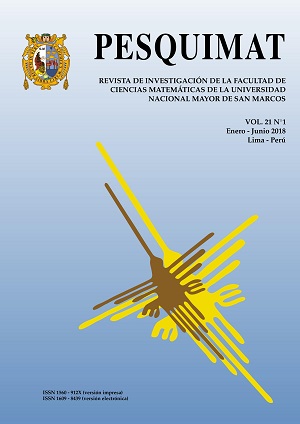K-Vecino más próximo en una aplicación de clasificación y predicción en el Poder Judicial del Perú
DOI:
https://doi.org/10.15381/pes.v21i1.15077Palabras clave:
clasificación supervisada y no supervisada, k-vecinos más próximos, clasificación no paramétrica, partición, validación cruzada aleatoria.Resumen
Este artículo resume las contribuciones principales de la tesis con el título “K-vecino más próximos en una aplicación de clasificación y predicción en el Poder Judicial del Perú". En esta tesis se construye un modelo utilizando el método de los k-vecinos más próximos que permite clasificar y predecir las Cortes Superiores de Justicia del Perú. Mediante un análisis descriptivo de datos se excluye la Corte de Lima del estudio. Con las restantes 30 Cortes Superiores, se genera un modelo de tres grupos fundado en clasificación no supervisada, para ello se deduce la matriz de distancia euclidiana que origina el árbol de clasificación. Se construye el modelo de clasificación de tres vecinos más próximos, con partición y pliegues de validación cruzada aleatoria, que indica; el modelo de espacio de predictores, el error cuadrático o índice de error que valida el valor óptimo de k = 3 vecinos, el error del modelo y el índice global de pronostico que miden la precisión o exactitud del modelo encontrado, importancia del predictor, mapas de cuadrantes y tabla de vecinos.
Descargas
Publicado
Número
Sección
Licencia
Derechos de autor 2018 Nel Quezada Lucio

Esta obra está bajo una licencia internacional Creative Commons Atribución-NoComercial-CompartirIgual 4.0.
LOS AUTORES RETIENEN SUS DERECHOS:
a) Los autores retienen sus derechos de marca y patente, y tambien sobre cualquier proceso o procedimiento descrito en el artículo.
b) Los autores retienen el derecho de compartir, copiar, distribuir, ejecutar y comunicar públicamente el artículo publicado en la revista Pesquimat (por ejemplo, colocarlo en un repositorio institucional o publicarlo en un libro), con un reconocimiento de su publicación inicial en la revista Pesquimat.
c) Los autores retienen el derecho a hacer una posterior publicación de su trabajo, de utilizar el artículo o cualquier parte de aquel (por ejemplo: una compilación de sus trabajos, notas para conferencias, tesis, o para un libro), siempre que indiquen la fuente de publicación (autores del trabajo, revista, volumen, numero y fecha).






